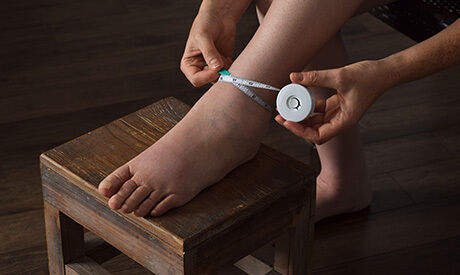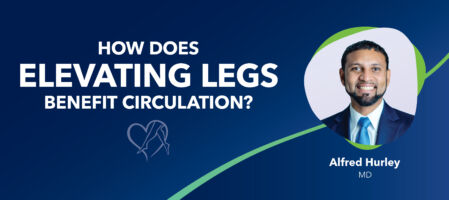
Eight Common Causes of Leg Swelling
The reasons for leg swelling are varied and range from mundane to severe. Learn the most common reasons for leg swelling and where to seek medical attention. Here are 8 common causes:

Medically reviewed by Alfred Hurley, MD, on July 30, 2025
Have you ever been told to "put your feet up" after a long day? It turns out that this common advice isn't just about relaxing; it's proven to be beneficial to your circulation, especially if you suffer from vein issues such as varicose veins or leg swelling. Elevating your legs can help relieve discomfort, reduce swelling, and support healthier blood flow in your lower body.
At Center for Vein Restoration (CVR), we understand the importance of proper leg care in maintaining strong circulation and preventing vein disease. In this post, Alfred Hurley, MD, lead physician at our McLean, VA, vein clinic, walks you through the right way to elevate your legs, how long to do it, what tools to use, and what to avoid. Let’s make sure you're getting the most out of this simple but powerful habit.
Ready for professional advice? Start by scheduling a consultation with CVR’s board-certified vein experts. We’ll walk you through each step of your vein care journey, starting with an in-depth evaluation of your current vein health, continuing with treatment options, and follow-up care. Call 240-965-3915 to contact our caring Patient Services Representatives or click the button below to book an appointment online at a CVR close to you. ⬇️

Before diving into how to do it, let’s take a moment to understand why elevating your legs helps circulation.
Your veins are responsible for directing blood back to your heart. According to Healthline, this process is more difficult in the legs since blood must travel upward and against gravity. Over the course of the day, especially if you spend much of it sitting or standing, blood can begin to pool in the veins of your legs, increasing pressure and the risk of problems including varicose veins, leg heaviness, and swelling (edema).
Elevating your legs allows gravity to help move blood back toward your heart more efficiently, reducing the pressure in your leg veins and giving your circulatory system a much-needed break.
Simply putting your feet on a footstool may not be sufficient to provide the support needed to direct the blood from your legs up toward your heart. It’s critical to elevate your legs properly to truly support healthy circulation. Here’s how:
This position allows gravity to assist in draining the blood from your lower limbs back toward your upper body, giving your veins a break from constantly working against gravity.
IMPORTANT: Elevating your legs should feel comfortable and relaxing. If you feel pain, tingling, or numbness, adjust your position or check with a vein specialist.
Here’s some good news: elevating your legs doesn’t have to take hours out of your day. For most people, the recommendation is 15 to 20 minutes, two to three times a day. That said, if you’re managing chronic vein issues or swelling, your doctor may suggest longer or more frequent sessions.
Struggling to find a time to fit this self-care tip into your routine? Here are some helpful hints:
Consistency is key. Elevating your legs regularly can help reduce symptoms and improve how your legs feel throughout the day.
Mistakes to Avoid When Elevating Your Legs for Circulation
While leg elevation is generally safe and beneficial, there are some common mistakes to avoid:
If you experience pain, tingling, or numbness while elevating your legs, stop and consult with a specialist. Leg elevation should never cause discomfort.
Elevating your legs is a great way to support your vein health, but it’s not a stand-alone solution for chronic vein conditions. If you’re managing symptoms other than just occasional swelling (such as aching, visible varicose veins, or skin discoloration), you’re likely dealing with a medical condition that requires more than lifestyle changes.
Vein disease often progresses quietly, and while elevation and other home remedies can ease symptoms in the moment, they don’t stop the disease process itself. That’s something only professional treatment can do. Vein care procedures offer something elevation simply can’t: diagnosis and treatment of the root cause. Modern options are safe, outpatient, and tailored to your specific vein map and medical history.
That said, your daily habits still matter. In fact, elevation can enhance recovery and improve outcomes after treatment. So, rather than thinking in terms of one or the other, consider leg elevation as part of your vein care toolkit. Listening to your body and seeking medical input when symptoms persist is a sign of taking ownership of your health. You're not giving up on self-care; you’re expanding it to include expert support.
At the CVR, our board-certified vein specialists offer expert diagnostics and minimally invasive treatments to boost circulation and provide long-lasting relief from common vein disease symptoms.
👉 Take the first step toward healthier legs and schedule a consultation today by calling our Patient Services Representatives at 240-965-3915. You can also use our ONLINE SCHEDULING PORTAL to book an appointment at one of our 120+ nationwide clinics.

Remember, taking a few minutes to elevate your legs each day is a small act of self-care that can lead to real improvements in how your legs look and feel. It’s easy, affordable, and effective, especially when paired with expert vein care.
If you're unsure whether leg elevation is helping or want to explore long-lasting treatment options, we’re here for you. Contact CVR today and let us help you get back to living comfortably and confidently.
✅ Schedule a consultation with Dr. Alfred Hurley in McLean—CLICK HERE.
✅ Not near McLean? Call 240-965-3915 to speak with a friendly Patient Services Representative or BOOK ONLINE at any of our 120+ CVR vein clinics nationwide.
